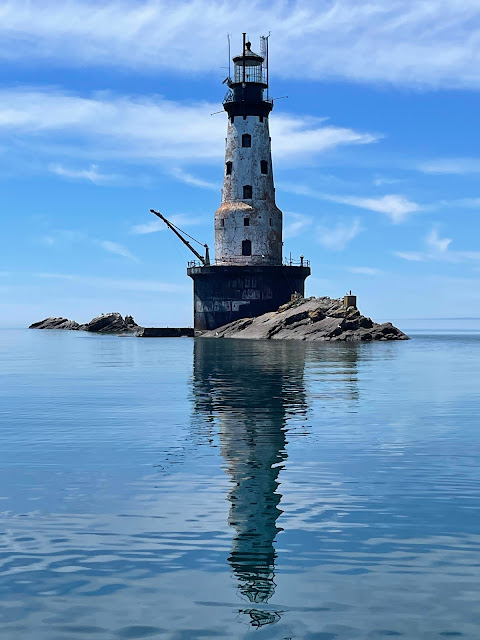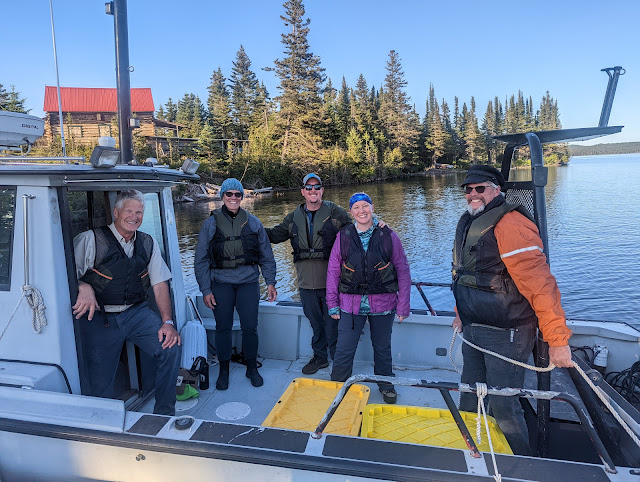Preserving the Memories
Back to the Rock
The six horse sailing motor had been pushing our small sailboat through the fog for a couple of hours when my father announced we should be arriving any moment. As he said that, the fog horn that we had been tracking gave another blast that sounded very near by, but from exactly which direction was hard to know. Just then, at a distance that relieved my mother, a majestic lighthouse perched on a lonely small rock emerged out of the fog. Distance was important because the light marked an area of rocks and reefs that had sunk a number of ships in the past. Relief also to us kids because it meant we were close to our destination of Isle Royale, and that soon we’d be getting off of that 22 foot sailboat.
Rock of Ages lighthouse, a tall tower that sits on a small rock at the southwest end of Isle Royale, is the gateway to the Isle of many smaller islands, coves, and bays with great protection from the big lake. To me, when I thought of how the 137 foot, ten story tower might have been built back in 1908, without any support structure, it always symbolized ingenuity and fortitude. The rock needed to be blasted to provide a flat area for the foundation, and a 50 foot in diameter steel cylindrical wall erected and filled with concrete, not to mention the steel and brick tower that would end up hosting a 3500 pound fresnel lens from France. Until 1978, a crew of lighthouse keepers operated and maintained the light, living on four floors with marginal space. Over the years I heard stories of how those crews did or did not maintain their sanity in those close quarters over weeks and months, and of shipwrecks that occurred in spite of the lighthouse. Approaching that light on the way to Isle Royale or passing on the way to Canada, either in a small sailboat or years later as an adult on the Skipper Sam, it always ignited my imagination with what it must have been like as construction workers and lighthouse crew toiled and fought with the lake those many years ago.
Lighthouse Preservation
The article in the newsletter “Around the Circle This Week,” from Lake Superior Magazine said, “Do a Lighthouse a Favor: Rock of Ages Lighthouse Preservation Society is looking for a few good women and men to volunteer this coming season. The group is accepting applications through Feb. 25 for boat drivers and restoration crew leaders.”
With my eyes always open for active volunteer opportunities, and for opportunities to boat or be on the water, especially if on Lake Superior, I clicked on the link and read their thorough and informative organization and position descriptions. Running a boat from a rustic cabin on Barnum Island, near where I met my wife and where her father had tried to raise a shipwreck those many years back, with trips back and forth to the lighthouse and to Windigo Ranger Station? Sounded too good to be true. Only catch was a minimum commitment for boat drivers of three weeks, two weeks longer than the commitment for restoration volunteers. Would they really put up with me for three weeks?
The group seemed very well organized, which proved to be true. To get a better feel for operations, the boat, and living conditions, I volunteered to join the opening crew to help with moving supplies and preparing the cabin for the season. When I met Mark, the boat driver I would be replacing in three weeks, he had already launched the 25 foot Boston Whaler called the “Rock Hopper.” He invited me for a trial run so we could familiarize ourselves with the controls and navigation instruments, so I jumped at the chance. We had just exited the marina breakwater when an alarm sounded with a message, “water in the fuel.” Turning back to the marina, and for the next hour, Mark worked to drain the strainers of water captured by the ethanol in the fuel. That problem would recur on the crossing, but never affected the two 150 horse Mercury motors attached to the transom. The boat listed to starboard a bit, corrected by the engine trim underway, and was certainly stern heavy due to the size of the motors. And apparently due to the fact that the boat, donated by the National Park Service at Indiana Dunes National Park as surplus, is a bit waterlogged. Other than that, the Whaler seemed very sturdy and capable of handling the weight of supplies and passengers.
In the two days leading up to meeting the Ranger III, we worked to clean and prepare the cabin, which didn’t take much since it was in good shape since last seasons closing. With time on our hands, Rachael (another experienced crew leader that made the crossing with us) and I joined local fishing family descendent Jeff Sivertson in his effort to restore the historic Sivertson fish house. We donned scrapers and paint brushes to paint the outside of the house while Jeff continued laying joists and floor boards in his restoration of the floor. The lakes rise, combined with age of the house, had submerged the existing floor, so he was simply building a new one on top of it. The Society often helps local island families and cabin dwellers maintain and restore historic properties in the area when weather makes time available. More on these families and their new group charged with similar restoration of buildings in Washington Harbor in future posts.
By the time Rachael was set to leave for home, the cabin was home to the seven of us. It was clear to me that the crew leader and his family, along with Mark, would be more comfortable with one or two fewer in the room. Since I was scheduled to return on the Sea Hunter the day after, I thought I’d join her in case they had room. Which they didn’t. Upon arriving back to the cabin, Jeff mentioned that his fishing friends were planning to return in their boat later that afternoon, and would I care to join them? Heck yeah.
That allowed me to get back to Duluth a day earlier then planned, giving time for a layover instead of trying to stay awake that night to get back to Afton at my scheduled time.
Exploring the area, working on the boat and on the island, meeting some of the harbor mates, watching an experienced crew work, all prepared me well for the main chapter of this adventure - three weeks in the back yard of both family and local history.








Comments
Post a Comment